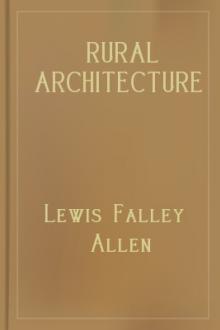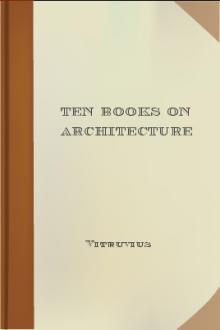The Architecture and Landscape Gardening of the Exposition by Louis Christian Mullgardt (old books to read .txt) 📖

- Author: Louis Christian Mullgardt
- Performer: -
Book online «The Architecture and Landscape Gardening of the Exposition by Louis Christian Mullgardt (old books to read .txt) 📖». Author Louis Christian Mullgardt
Court of the Universe Fountain of the Rising Sun
In the eastern portion of the sunken garden is the Fountain of the Rising Sun. The tall, slender shaft, a column of travertine by day and a column of light by night, supports a sphere upon which is poised a statue typifying the dawn of day. Adolph A. Weinman is the sculptor of this “Rising Sun” which is so deservedly popular on account of the irresistible appeal of the youthful figure.
Everything about the fountain is indicative of the vigor of youth, the energy associated with the rising of the sun. The friezes about the base represent the triumph of light over darkness, and the merry play of waters suggests perpetual activity. The concrete bowl is of goodly proportions and within the pool are sculptured figures representing mythical creatures of the ocean.
Bordering the fountain are gardens, at first ablaze with rhododendrons, then massed with the pink blooms of hydrangeas, and later bright with the flowers of each successive season.
Court of the Universe Fountain of the Setting Sun
Quite as lovely in every detail as the preceding is the Fountain of the Setting Sun. It is in the opposite portion of the sunken garden where, when the sun is in its descent, it is shadowed by the Triumphal Arch of the Nations of the West.
Crowning the pillar is the figure of a maid, her drooping wings and languorous pose denoting relaxation, a suspension of the day’s toil. This statue was also modeled by Adolph A. Weinman. The supporting shaft conveys an impression of buoyancy and there are friezes above and below the bowl of the fountain similar to those of the Rising Sun. At night the columns which support these figures are aglow with concealed lights, and the beauty of the fountain is wonderfully enhanced.
Court of the Universe The Fountain Pool and Tower
The inscriptions on the two Triumphal Arches in the Court of the Universe are drawn respectively from Occidental and Oriental literature. It was designed that the large central panels possess a cosmical, an epical, or an elemental quality, and that the smaller panels on either side deal with abstractions, such as truth, nature or beauty. In accordance with this plan, the inscriptions on the Arch of the Setting Sun facing away from the court are as follows:
The panel at the left of the attic, representing Italy, reads
The world is in its most excellent state when justice is supreme.— Dante.
The panel in the center of the attic, representing Germany, is inscribed
It is absolutely indispensable for the United States to effect a passage from the Mexican Gulf to the Pacific Ocean; and I am certain that they will do it. Would that I might live to see it—but I shall not.—Goethe.
The panel at the right of the attic, representing France, reads
The Universe, an infinite sphere, the center everywhere, the circumference, nowhere. Pascal.
Court of the Universe Corinthian Colonnade & Gardens
The inscriptions on the Arch of the Setting Sun, facing the Court, are as follows:
The panel at the left of the attic, representing England, reads
In nature’s infinite book of secrecy a little I can read.—Shakespeare.
The panel in the center of the attic, representing America, reads
Facing west from California’s shores, Inquiring, tireless, seeking what is yet unfound, I, a child, very old, over waves Towards the house of maternity, The land of migrations look afar, Look off the shores of my western sea, The circle almost circled.
—Whitman.
The panel at the right of the attic, representing Spain, is inscribed
Truth, witness of the past, councillor of the present, guide of the future.—Cervantes.
Court of the Universe In the Promenade by Night
The inscriptions on the Arch of the Rising Sun, facing the Court, are as follows:
The panel at the left of the attic, representing China, is inscribed
They who know the truth are not equal to those who love it.—Confucius.
The panel in the center of the attic, representing India, reads
The moon sinks yonder in the west, While, in the east, the glorious sun Behind the herald dawn appears Thus rise and set in constant change those shining orbs And regulate the very life of this our world.
—Kalidasa.
The panel at the right of the attic, representing Japan, reads
Our eyes and hearts uplifted, seem to gaze on heaven’s radiance.— Hitomaro.
Court of the Universe A Niche and Urn by Night
The inscriptions on the Arch of the Rising Sun, facing away from the Court, are as follows:
The panel at the left of the attic, representing Arabia, reads
He that honors not himself lacks honor wheresoe’er he goes.—Zuhayr.
The panel in the center of the attic, representing Persia, is inscribed
The balmy air diffuses health and fragrance, So tempered is the genial glow that we know neither heat nor cold. Tulips and hyacinths abound. Fostered by a delicious clime, the earth blooms like a garden.
—Firdausi.
The panel at the right of the attic, representing Spain, reads
A wise man teaches, be not angry; from untrodden ways turn aside.—Phra Ruang.
Palace of Transportation In the Corinthian Colonnade
This promenade, formed by the vast portico of the Palace of Agriculture, is in harmony with the architectural scheme of the Court of the Universe. It is the eastern wall of the aisle leading from the the main court to the Column of Progress.
The shafts of the pillars are fluted and capped after the Corinthian order. Terra cotta, mellow in tone, is the color which has been used upon the travertine material of the columns, and the walls flanking the majestic array of pillars are painted a warm pink. The height of the ceiling is intensified by its deep blue, which seems to blend with the azure of the sky, as one glimpses it through the far opening of the corridor. Masked lanterns adorn the arched ceiling; on the columns are shell-screened lamps and at night the sweep of the promenade is magnified by the indirect lighting effects.
Venetian Court Palace of Agriculture
The great triumphal arches of the Central Court dominate the connecting aisles on either side, the Arch of the Rising Sun forming the west side of the Florentine Court and the Arch of the Setting Sun the east side of the Venetian Court. All the splendor and dignity of architectural treatment and decorative ornament that enrich the arches as they face toward the Court of the Universe are repeated on the reverse sides.
The treatment of the side walls in the Florentine and Venetian Courts is identical, displaying some of the most delightful features of the Italian Renaissance, with marked richness in the use of both color and ornament. The walls are covered with a diaper pattern in pink and warm ivory. Bright blue and deep orange stain the overhanging cornice. The great windows are latticed and bound with green, the keystone of their arches being a quaint figure with folded wings. Between the arches are inset blue Italian medallions. Between the windows are coupled Corinthian columns, their shafts richly overlaid with ornament after patterns suggested by the churches and palaces of southern Italy. The planting is profuse, with masses of green against the walls and a wealth of bloom, pink predominating in the Florentine Court and yellow in the Venetian.
Court of the Four Seasons The Night Illumination
The Court of the Four Seasons is the most restful, the most intimate and the most harmonious of the three main courts, an effect produced by its classic simplicity and the charm of its architecture, sculpture and planting.
The long approach of the north court, which is entered from the Esplanade, is bordered by the stately colonnades of the Palace of Agriculture on the east and the Palace of Food Products on the west. The columns are Ionic, the decorative treatment of their capitals, and of the frieze above, being in fruits and grains, happily conventionalized. The green sward of the avenue is set, here and there, with fine yew trees, while tall, slim eucalypti flank the entrance to the Court.
The Fountain of Ceres designed by Evelyn Beatrice Longman, by the poise of its crowning figure and by the grace and dignity of its entire outline, no less than by its classic conception and fine architectural feeling, enhances the chaste beauty of the long vista whether seen by day outlined against the misty bay and the sweep of hills beyond, or by night, silhouetted against the white rays of the scintillators which are placed on the harbor’s edge.
Court of the Four Seasons The Great Half Dome
The theme of the Court, the fruitfulness of the changing seasons, is sympathetically rendered by architecture, sculpture and painting in happy combination. The decorative forms all employ agricultural motives, and the sculptured groups or figures and the mural paintings are variations of the same thought.
In architecture, the Court, which was designed by Henry Bacon of New York, is almost severely classic, enriched in its minor details by touches of the Italian Renaissance. The Half Dome, which lies directly opposite the long northern approach, is modeled after Hadrian’s villa near Rome. The decoration of the vault of the dome is influenced by the richer coloring of the Court of Palms into which it opens on its inner side, while the archway softens into lighter tones in harmony with the more delicate coloring of the Court of the Four Seasons.
The fine balance of line and proportion which characterizes the Court is shown in the three sculptured figures by Albert Jaegers,—“Harvest,” the seated figure which fitly crowns the half dome, blending finely with its nobility and strength of outline, and “Rain” and “Sunshine,” which surmount the splendid columns of Sienna marble on either side of the dome.
Court of the Four Seasons The Western Archway
The east and west entrances to the Court are massive archways, most satisfying in their purity and dignity of architectural form and treatment, as well as in the superb outlook which they give on either hand. The arches are divided by Corinthian pilasters of Sienna marble. Within, their vaulted ceilings are delicately colored and modeled in faint relief after ancient classic designs, suggesting harvest scenes. The spandrels in the triangles over the curve of the arch and the four times repeated figures which serve as pilasters in the paneled attic space above, are by August Jaegers. All are gracefully molded women’s figures, and all alike are emblematic of the richness of the harvest. The signs of the zodiac letter the cornice between the arches and the attic. The inscription above the eastern gateway is from Spenser’s “Faerie Queene,” and that over the western from “The Triumph of Bohemia” by George Sterling.
The serenity and intimate seclusion of the Court are due perhaps more than to any other single feature, to the quiet, circular pool in its center, shut in by banks of shrubbery and bare of sculptured ornament.
Court of the Four Seasons One of the Colonnade Murals
The Court is octagonal in shape, by reason of the fountains, screened by stately rows of columns, which fill its cornet recesses. These corner fountains are distinctly Roman in inspiration, the detail being suggested by the baths of Caracalla. Between the double rows of massive Ionic columns runs the colonnade. The capitals of the columns are enriched by pendant ears of corn, surmounted by a single open flower. Above the severely treated doorways, in each





Comments (0)